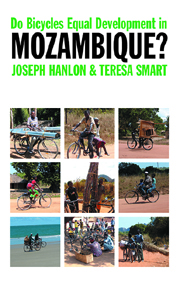Book contents
- Frontmatter
- Contents
- Acknowledgements
- The authors
- Money & measurements
- Abbreviations, acronyms & glossary
- Part I IS THERE DEVELOPMENT IN MOZAMBIQUE?
- 1 Introduction: more bicycles, but …
- 2 A brief history: war, peace & slow recovery
- 3 Can peasants pull Nampula out of poverty?
- 4 The Manica miracle is over
- 5 Cashew: from disaster to export model
- 6 Tobacco: hard choices
- 7 Has poverty decreased?
- 8 Is there development in Mozambique?
- Part II ACTORS & CONTEXT
- Part III ALTERNATIVES & THE DEVELOPMENTAL STATE
- Appendix 1 Aid
- Appendix 2 Investment & other tables
- Bibliography
- Index
4 - The Manica miracle is over
from Part I - IS THERE DEVELOPMENT IN MOZAMBIQUE?
Published online by Cambridge University Press: 05 April 2013
- Frontmatter
- Contents
- Acknowledgements
- The authors
- Money & measurements
- Abbreviations, acronyms & glossary
- Part I IS THERE DEVELOPMENT IN MOZAMBIQUE?
- 1 Introduction: more bicycles, but …
- 2 A brief history: war, peace & slow recovery
- 3 Can peasants pull Nampula out of poverty?
- 4 The Manica miracle is over
- 5 Cashew: from disaster to export model
- 6 Tobacco: hard choices
- 7 Has poverty decreased?
- 8 Is there development in Mozambique?
- Part II ACTORS & CONTEXT
- Part III ALTERNATIVES & THE DEVELOPMENTAL STATE
- Appendix 1 Aid
- Appendix 2 Investment & other tables
- Bibliography
- Index
Summary
If Nampula seems likely to grow on the basis of small-scale peasant agriculture, the engine of growth for Manica province was set to be larger commercial agriculture. The 2001– 4 Manica boom was triggered by the crisis in Zimbabwe. Tobacco companies encouraged Zimbabwean farmers to migrate to Manica by offering credit and technical assistance; paprika companies also provided support. In the end 42 Zimbabwean individuals and groups settled in Manica and a similar number of Mozambicans (and foreigners already permanently resident in Mozambique) received support. The Zimbabwean farmers alone created 4,385 jobs in 2003 and estimated that they were putting $1.6 m. into the economy annually in wages. Four agro-processing units were opened – to export roses and vegetables to Europe and to produce sunflower oil and milk for local sale – which created hundreds more jobs. At the peak, 3600 peasant families were growing sunflower and more than 3000 growing paprika. Over 100 groups were organised to grow baby corn and other export vegetables.
By the end of 2006, the Manica miracle had turned into a mirage. Only 16 Zimbabwean commercial farmers were left and half of these were expected to quit in 2007; employment was down to 600 (Evans 2006). Three of the four agro-processing units had closed. Few peasants could earn even 1000 MT ($40, £20) from paprika, and support was being reduced. Although not a total disaster, serious foreign investment has proved very limited; a new cheese factory linked to milk production, a milling company, and an attempt to revive export vegetable production.
- Type
- Chapter
- Information
- Do Bicycles Equal Development in Mozambique? , pp. 27 - 35Publisher: Boydell & BrewerPrint publication year: 2008



